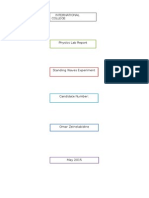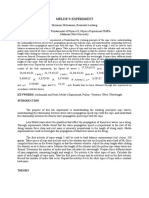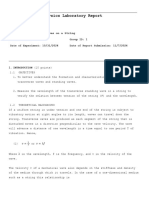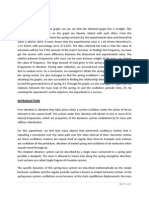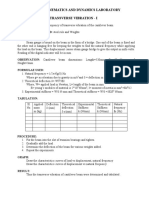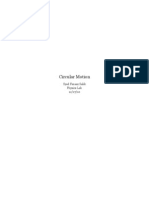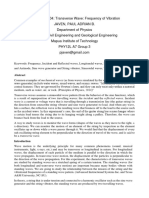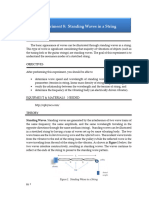Experiment Wave Motion
Experiment Wave Motion
Uploaded by
amazinjonCopyright:
Available Formats
Experiment Wave Motion
Experiment Wave Motion
Uploaded by
amazinjonCopyright
Available Formats
Share this document
Did you find this document useful?
Is this content inappropriate?
Copyright:
Available Formats
Experiment Wave Motion
Experiment Wave Motion
Uploaded by
amazinjonCopyright:
Available Formats
Experiment: Wave Motion Ton 5/12/2011 Adams
Hai Jon
Experiment: Wave Motion
Purpose The purpose of this experiment was to use our equipment to investigate wave motion on a cord.
Materials 1 1 1 2 1 1 1 1 1 1 1 String vibrator Elastic cord Sine wave generator Connecting wires (banana plug) Table top pulley Threaded metal rod Large C clamp Mass hanger Set of slotted masses Meter stick Triple beam balance
Procedure The first step in this experiment was to assemble the wave generating apparatus. The equipment was well chosen and came together with ease. We attached a 300 g
Experiment: Wave Motion Ton 5/12/2011 Adams
Hai Jon
slotted mass to the cord hanging over the table top pulley. We adjusted the string vibrator base so the distance between the vibrator and table top pulley was about 1 meter. We also measured and recorded the distance H between the hanging mass and the table top pulley. We calculated the linear mass density of the cord and the tension in the cord. The next thing was to set the sine wave generator to constant amplitude and adjust the frequency until we achieved a fundamental wave. We recorded that frequency and continued to adjust the frequency until we observed a standing wave with 2 segments. We continued this process for n segments until we observed 7. For part II of this experiment we set the frequency to 80 Hz and adjusted length L by sliding the string vibrator base back and forth. As length L changed we recorded L when we observed a standing wave with n segments. The following equation was used to calculate frequency:
fn =
n 2L
Data and Results: The following data was collected during the experiment for Part I. mstring (kg) mslot-mass (kg) mhanger (kg) 6.5 x10-3 0.300 50.0 x10-3
n 1 2 3 4 5 6 7
L (m) 0.85 0.85 0.85 0.85 0.85 0.85 0.85
H(m ) 0.36 0.36 0.36 0.36 0.36 0.36 0.36
=m(L+H) (kg/m) 0.0054 0.0054 0.0054 0.0054 0.0054 0.0054 0.0054
(N) 3.45 3.45 3.45 3.45 3.45 3.45 3.45
fn measured (Hz) 14.00 28.00 45.10 59.40 73.90 88.20 103.20
fn calculated (Hz) 14.87 29.74 44.61 59.47 74.34 89.21 104.08
% error (%) 5.85 5.85 1.10 0.118 0.592 1.13 0.846
Experiment: Wave Motion Ton 5/12/2011 Adams
Hai Jon
The linear mass density of the elastic cord, found by taking the mass of the string divided by the total length of the string and is the tension in the cord and found by taking the sum of the mass of the string, mass of the hanger and mass of the slotted mass and multiplying by the gravitational acceleration, g.
m ( l + h)
= ( ms + m sh + H ) g
6.5 x103 1.21
= ( 0.05 + 0.3 + ( 0.0054) 0.36) 9.81 = 3.4526
= 0.0054
Frequency for Part I:
1 3.45 2(0.85) 0.0054 f n = 14.87Hz fn =
The formula was applied to the remaining segments. The following data was collected during the experiment for Part II. mstring (kg) mslot-mass (kg) mhanger (kg) 3.5 x10-3 0.300 50.0 x10-3
L (m)
H(m )
=m(L+H) (kg/m)
(N)
fn Measured (Hz)
fn calculated (Hz)
% error (%)
Experiment: Wave Motion Ton 5/12/2011 Adams 1 2 3 4 0.19 0.38 5 0.58 0.76 0.66 0.45 0.27 0.09 0.0041 0.0041 0.0041 0.0041 3.46 3.45 3.44 3.44 80.00 80.00 80.00 80.00 76.45 75.34 74.91 76.23
Hai Jon
4.64 6.19 6.79 4.95
m ( l + h)
= ( m s + m sh + H ) g
.0035 0.85
= ( 0.05 + 0.3 + ( 0.0041* 0.66) ) 9.81 = 3.46
= 0.0041
Frequency for Part II:
1 3.46 2(0.19) 0.0041 f n = 76.45Hz fn =
Error Analysis
% error = % error =
f n calculated f n measured x100% f n calculated
14.87 14 x100% 14.87 %error = 5.85%
The formula was applied to the remaining segments and displayed on the following graph.
Experiment: Wave Motion Ton 5/12/2011 Adams
Hai Jon
The graph seems to be linear which indicates that there is a linear relationship between the number of segments and the frequency. With a more in depth analysis, we can see that the transverse speed is constant and the wavelength has an inverse proportional relationship with the frequency. Only when the transverse speed is constant; decreasing the wavelength (increasing the number of segments) will increase the frequency, and vice versa.
Conclusion By following the procedure of this experiment we were able to calculate the frequency of a standing wave. We were able to observe waves on a string at different frequency which gives us some intuition into understanding waves. We discovered that we could calculate the frequency with a fair amount of accuracy. We ran into one small problem which had to do with the cord. In part two we shortened the length L of the cord hence changing the linear mass density. We did not immediately compensate for the linear mass density change, therefore our calculations were off. A second look led us to the solution and we quickly corrected it. Suggestions for Improvement This experiment was very helpful and we felt that it was well organized. One possible improvement would be to increase the height of the table used to set up the apparatus. The height of the table limited us in part II because the movement of string vibrator base was dependent on the height of the table. We were able to work around this by shortening our elastic cord, thus changing our linear mass density. Overall, the experiment was well put together.
You might also like
- Lab Report No 3 Standing Waves On Stings Phyisc 212No ratings yetLab Report No 3 Standing Waves On Stings Phyisc 2127 pages
- Anjali Jindal - Exp No.1 - Melde's ExperimentNo ratings yetAnjali Jindal - Exp No.1 - Melde's Experiment9 pages
- SEBP4418-10-02 Excavadora 324D Serie CJX1-up, (Machine), DFP1-up, (Machine), KHX1-up (Engine) PDFNo ratings yetSEBP4418-10-02 Excavadora 324D Serie CJX1-up, (Machine), DFP1-up, (Machine), KHX1-up (Engine) PDF1,073 pages
- Experiment 7: Waves On A Vibrating String: Vincent Vuong March 4th, 2014 Tuesday 11am Roli Esha Ming-Hei TaiNo ratings yetExperiment 7: Waves On A Vibrating String: Vincent Vuong March 4th, 2014 Tuesday 11am Roli Esha Ming-Hei Tai8 pages
- Standing Wave On A String: Laboratory of Basic Physics Department of Physics FMIPA Makassar State UniversityNo ratings yetStanding Wave On A String: Laboratory of Basic Physics Department of Physics FMIPA Makassar State University12 pages
- Frequency Wavelength Speed Experiment Philip SalmonyNo ratings yetFrequency Wavelength Speed Experiment Philip Salmony1 page
- SCRIBD- Transverse Standing Waves on a StringNo ratings yetSCRIBD- Transverse Standing Waves on a String5 pages
- Name: Anil Rochester ID#: Date: Lab Partners: Lab Instructors: Lab #No ratings yetName: Anil Rochester ID#: Date: Lab Partners: Lab Instructors: Lab #9 pages
- Transverse Cantiliver, Free, Simply SupportedNo ratings yetTransverse Cantiliver, Free, Simply Supported3 pages
- Me8511 Kinematics and Dynamics Laboratory Ex No: Transverse Vibration - INo ratings yetMe8511 Kinematics and Dynamics Laboratory Ex No: Transverse Vibration - I16 pages
- Lab 2 - Vibrations of A Cantilever BeamNo ratings yetLab 2 - Vibrations of A Cantilever Beam11 pages
- Physics Lab Report 2 - Camryn Williams 2No ratings yetPhysics Lab Report 2 - Camryn Williams 211 pages
- An Approximation of The Acceleration of Gravity Using Experimental Methods With Period, Amplitude, and Length DependenciesNo ratings yetAn Approximation of The Acceleration of Gravity Using Experimental Methods With Period, Amplitude, and Length Dependencies5 pages
- 4.0 Procedure A. Free and Undamped OscillationNo ratings yet4.0 Procedure A. Free and Undamped Oscillation4 pages
- MEC424-Vibration: Oscillations Periodic RandomNo ratings yetMEC424-Vibration: Oscillations Periodic Random6 pages
- Catling, Johnoricks Ace C.-Phy12l B4-E304-4q1617 PDFNo ratings yetCatling, Johnoricks Ace C.-Phy12l B4-E304-4q1617 PDF3 pages
- Instructions and Advices To Use The Electronic Controller Logik 18No ratings yetInstructions and Advices To Use The Electronic Controller Logik 1825 pages
- Chapter 1 - Fundamentals of Cooling SystemsNo ratings yetChapter 1 - Fundamentals of Cooling Systems47 pages
- Instant Ebooks Textbook Hybrid Energy Systems For Offshore Applications Ibrahim Dincer Download All ChaptersNo ratings yetInstant Ebooks Textbook Hybrid Energy Systems For Offshore Applications Ibrahim Dincer Download All Chapters49 pages
- Multi Range, Double Time Adjusted Flasher Relay: FUNCTION (Operation Mode)No ratings yetMulti Range, Double Time Adjusted Flasher Relay: FUNCTION (Operation Mode)1 page
- Chemical Reaction Engineering I Part A QNo ratings yetChemical Reaction Engineering I Part A Q26 pages
- Introducing Next Gen 600VA UPS: BX600C-INNo ratings yetIntroducing Next Gen 600VA UPS: BX600C-IN2 pages
- Blue Laser Pointer 20000mW High Power Millitary Laser PenNo ratings yetBlue Laser Pointer 20000mW High Power Millitary Laser Pen3 pages
- Lab Report No 3 Standing Waves On Stings Phyisc 212Lab Report No 3 Standing Waves On Stings Phyisc 212
- SEBP4418-10-02 Excavadora 324D Serie CJX1-up, (Machine), DFP1-up, (Machine), KHX1-up (Engine) PDFSEBP4418-10-02 Excavadora 324D Serie CJX1-up, (Machine), DFP1-up, (Machine), KHX1-up (Engine) PDF
- Experiment 7: Waves On A Vibrating String: Vincent Vuong March 4th, 2014 Tuesday 11am Roli Esha Ming-Hei TaiExperiment 7: Waves On A Vibrating String: Vincent Vuong March 4th, 2014 Tuesday 11am Roli Esha Ming-Hei Tai
- Standing Wave On A String: Laboratory of Basic Physics Department of Physics FMIPA Makassar State UniversityStanding Wave On A String: Laboratory of Basic Physics Department of Physics FMIPA Makassar State University
- Frequency Wavelength Speed Experiment Philip SalmonyFrequency Wavelength Speed Experiment Philip Salmony
- Name: Anil Rochester ID#: Date: Lab Partners: Lab Instructors: Lab #Name: Anil Rochester ID#: Date: Lab Partners: Lab Instructors: Lab #
- Me8511 Kinematics and Dynamics Laboratory Ex No: Transverse Vibration - IMe8511 Kinematics and Dynamics Laboratory Ex No: Transverse Vibration - I
- An Approximation of The Acceleration of Gravity Using Experimental Methods With Period, Amplitude, and Length DependenciesAn Approximation of The Acceleration of Gravity Using Experimental Methods With Period, Amplitude, and Length Dependencies
- Catling, Johnoricks Ace C.-Phy12l B4-E304-4q1617 PDFCatling, Johnoricks Ace C.-Phy12l B4-E304-4q1617 PDF
- Simple Definition And Explanation Of Force In PhysicsFrom EverandSimple Definition And Explanation Of Force In Physics
- Instructions and Advices To Use The Electronic Controller Logik 18Instructions and Advices To Use The Electronic Controller Logik 18
- Instant Ebooks Textbook Hybrid Energy Systems For Offshore Applications Ibrahim Dincer Download All ChaptersInstant Ebooks Textbook Hybrid Energy Systems For Offshore Applications Ibrahim Dincer Download All Chapters
- Multi Range, Double Time Adjusted Flasher Relay: FUNCTION (Operation Mode)Multi Range, Double Time Adjusted Flasher Relay: FUNCTION (Operation Mode)
- Blue Laser Pointer 20000mW High Power Millitary Laser PenBlue Laser Pointer 20000mW High Power Millitary Laser Pen












